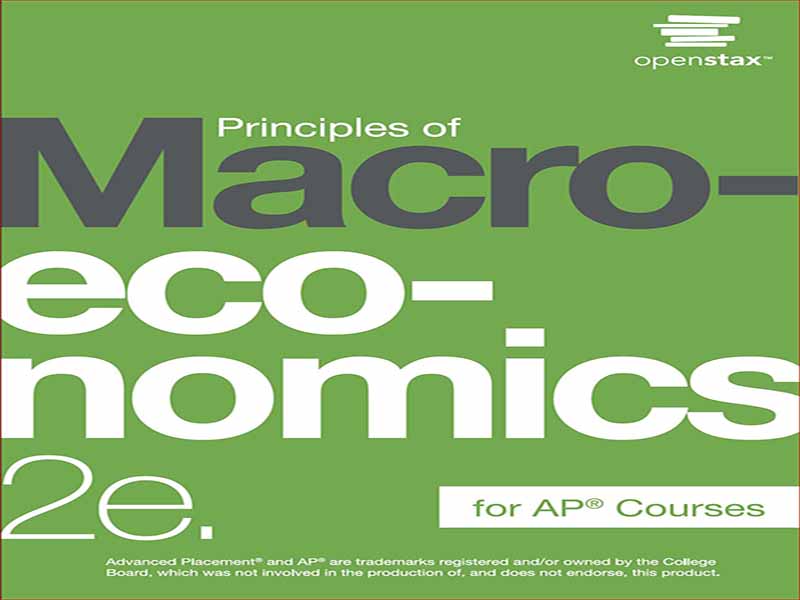- عنوان کتاب: Principles of Macroeconomics for AP Courses
- نویسنده: STEVEN A. GREENLAW
- حوزه: اقتصاد کلان
- سال انتشار: 2017
- تعداد صفحه: 547
- زبان اصلی: انگلیسی
- نوع فایل: pdf
- حجم فایل: 25.1 مگابایت
اصول اقتصاد کلان برای دوره های AP® 2e (ویرایش دوم) دامنه و الزامات توالی بیشتر دوره های مقدماتی اقتصاد کلان را پوشش می دهد. این متن شامل بسیاری از نمونههای فعلی است که به روشی منصفانه از نظر سیاسی مدیریت میشوند. نتیجه یک رویکرد متعادل به دیدگاه های کینزی و کلاسیک و نظریه و کاربرد مفاهیم اقتصاد است. ویرایش دوم برای افزایش وضوح، بهروزرسانی دادهها و تأثیرات رویداد فعلی، و ترکیب بازخوردهای بسیاری از بازبینکنندگان و پذیرندگان، بهطور کامل بازبینی شده است. برای توسعه نسخه اول اصول اقتصاد کلان، حقوق اصول اقتصاد تیموتی تیلور را به دست آوردیم و از مدرسان اقتصاد در تمام سطوح آموزش عالی، از کالج های محلی گرفته تا دانشگاه های اعطای دکترا، ایده هایی را درخواست کردیم. برای ویرایش دوم، بازخورد گستردهتر و کاربردیتری از صدها نفر از پذیرندگانی که از این کتاب برای چندین دوره دانشگاهی استفاده کرده بودند، دریافت کردیم. این مربیان آگاه دوره های آموزشی، توسعه و تحقق اهداف یادگیری و ترتیبات فصل را اطلاع رسانی کردند. اساتیدی که از مطالب تدریس می کردند، نظرات انتقادی و مفصلی ارائه کردند. نتیجه کتابی است که گستره مباحث اقتصاد را پوشش میدهد و همچنین عمق لازم را برای اطمینان از اینکه دوره برای مدرسان و دانشجویان قابل مدیریت است، فراهم میکند. ما سعی کردیم بین تئوری و کاربرد و همچنین میزان محاسبه و مثال های ریاضی تعادل برقرار کنیم. این کتاب در هفت بخش اصلی تنظیم شده است: اقتصاد چیست؟ دو فصل اول دانش آموزان را با مطالعه اقتصاد با تمرکز بر انتخاب در دنیایی با منابع کمیاب آشنا می کند. عرضه و تقاضا، فصول 3 و 4، اولین مدل تحلیلی در اقتصاد را معرفی و توضیح می دهد: عرضه، تقاضا و تعادل، قبل از نشان دادن کاربردها در بازارهای کار و مالی. کشش و قیمت، فصل 5، کشش و قیمت، دو مفهوم کلیدی در اقتصاد را معرفی و توضیح می دهد. چشم انداز اقتصاد کلان و اهداف، فصل های 6 تا 10، تعدادی از مفاهیم کلیدی را در کلان معرفی می کند: رشد اقتصادی، بیکاری و تورم، و تجارت بین المللی و جریان سرمایه. چارچوبی برای تحلیل اقتصاد کلان، فصول 11 تا 13، مدل تحلیلی اصلی را در کلان معرفی می کند، یعنی مدل تقاضای کل/ عرضه کل. سپس این مدل برای دیدگاههای کینزی و نئوکلاسیک اعمال میشود. مدل مخارج- ستانده به طور کامل در یک پیوست مستقل توضیح داده شده است. سیاست پولی و مالی، فصل های 14 تا 18، نقش پول و سیستم بانکی و همچنین سیاست های پولی و مقررات مالی را توضیح می دهد. سپس بحث به کسری بودجه و سیاست های مالی تغییر می کند. اقتصاد بین الملل، فصل 19 تا 21، بخش پایانی متن، ابعاد بین المللی اقتصاد، از جمله تجارت بین المللی و حمایت گرایی را معرفی می کند.
Principles of Macroeconomics for AP® Courses 2e (2nd edition) covers the scope and sequence requirements of most introductory macroeconomics courses. The text includes many current examples, which are handled in a politically equitable way. The outcome is a balanced approach to both Keynesian and classical views, and to the theory and application of economics concepts. The second edition has been thoroughly revised to increase clarity, update data and current event impacts, and incorporate the feedback from many reviewers and adopters. To develop the first edition of Principles of Macroeconomics, we acquired the rights to Timothy Taylor’s Principles of Economics and solicited ideas from economics instructors at all levels of higher education, from community colleges to PhD-granting universities. For the second edition, we received even more expansive and actionable feedback from hundreds of adopters who had used the book for several academic terms. These knowledgeable instructors informed the pedagogical courses, learning objective development and fulfillment, and the chapter arrangements. Faculty who taught from the material provided critical and detailed commentary. The result is a book that covers the breadth of economics topics and also provides the necessary depth to ensure the course is manageable for instructors and students alike. We strove to balance theory and application, as well as the amount of calculation and mathematical examples. The book is organized into seven main parts: What is Economics? The first two chapters introduce students to the study of economics with a focus on making choices in a world of scarce resources. Supply and Demand, Chapters 3 and 4, introduces and explains the first analytical model in economics: supply, demand, and equilibrium, before showing applications in the markets for labor and finance. Elasticity and Price, Chapter 5, introduces and explains elasticity and price, two key concepts in economics. The Macroeconomic Perspective and Goals, Chapters 6 through 10, introduces a number of key concepts in macro: economic growth, unemployment and inflation, and international trade and capital flows. A Framework for Macroeconomic Analysis, Chapters 11 through 13, introduces the principal analytic model in macro, namely the aggregate demand/aggregate supply Model. The model is then applied to the Keynesian and Neoclassical perspectives. The expenditure-output model is fully explained in a stand-alone appendix. Monetary and Fiscal Policy, Chapters 14 through 18, explains the role of money and the banking system, as well as monetary policy and financial regulation. Then the discussion switches to government deficits and fiscal policy. International Economics, Chapters 19 through 21, the final part of the text, introduces the international dimensions of economics, including international trade and protectionism.
این کتاب را میتوانید از لینک زیر بصورت رایگان دانلود کنید:


































نظرات کاربران